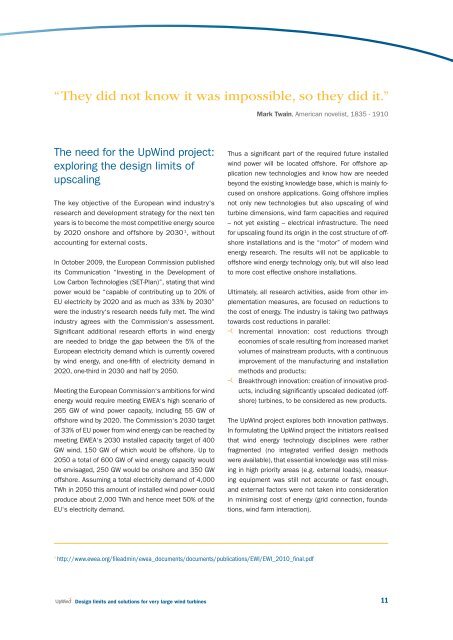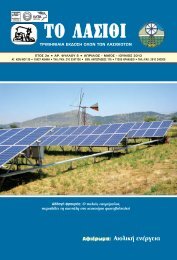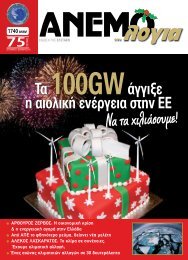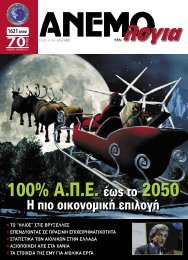Design limits and solutions for very large wind turbines
Design limits and solutions for very large wind turbines
Design limits and solutions for very large wind turbines
You also want an ePaper? Increase the reach of your titles
YUMPU automatically turns print PDFs into web optimized ePapers that Google loves.
“ They did not know it was impossible, so they did it.”<br />
Mark Twain, American novelist, 1835 - 1910<br />
The need <strong>for</strong> the UpWind project:<br />
exploring the design <strong>limits</strong> of<br />
upscaling<br />
The key objective of the European <strong>wind</strong> industry‘s<br />
research <strong>and</strong> development strategy <strong>for</strong> the next ten<br />
years is to become the most competitive energy source<br />
by 2020 onshore <strong>and</strong> offshore by 2030 1 , without<br />
accounting <strong>for</strong> external costs.<br />
In October 2009, the European Commission published<br />
its Communication “Investing in the Development of<br />
Low Carbon Technologies (SET-Plan)”, stating that <strong>wind</strong><br />
power would be “capable of contributing up to 20% of<br />
EU electricity by 2020 <strong>and</strong> as much as 33% by 2030”<br />
were the industry‘s research needs fully met. The <strong>wind</strong><br />
industry agrees with the Commission‘s assessment.<br />
Significant additional research ef<strong>for</strong>ts in <strong>wind</strong> energy<br />
are needed to bridge the gap between the 5% of the<br />
European electricity dem<strong>and</strong> which is currently covered<br />
by <strong>wind</strong> energy, <strong>and</strong> one-fifth of electricity dem<strong>and</strong> in<br />
2020, one-third in 2030 <strong>and</strong> half by 2050.<br />
Meeting the European Commission‘s ambitions <strong>for</strong> <strong>wind</strong><br />
energy would require meeting EWEA‘s high scenario of<br />
265 GW of <strong>wind</strong> power capacity, including 55 GW of<br />
offshore <strong>wind</strong> by 2020. The Commission‘s 2030 target<br />
of 33% of EU power from <strong>wind</strong> energy can be reached by<br />
meeting EWEA‘s 2030 installed capacity target of 400<br />
GW <strong>wind</strong>, 150 GW of which would be offshore. Up to<br />
2050 a total of 600 GW of <strong>wind</strong> energy capacity would<br />
be envisaged, 250 GW would be onshore <strong>and</strong> 350 GW<br />
offshore. Assuming a total electricity dem<strong>and</strong> of 4,000<br />
TWh in 2050 this amount of installed <strong>wind</strong> power could<br />
produce about 2,000 TWh <strong>and</strong> hence meet 50% of the<br />
EU‘s electricity dem<strong>and</strong>.<br />
Thus a significant part of the required future installed<br />
<strong>wind</strong> power will be located offshore. For offshore application<br />
new technologies <strong>and</strong> know how are needed<br />
beyond the existing knowledge base, which is mainly focused<br />
on onshore applications. Going offshore implies<br />
not only new technologies but also upscaling of <strong>wind</strong><br />
turbine dimensions, <strong>wind</strong> farm capacities <strong>and</strong> required<br />
– not yet existing – electrical infrastructure. The need<br />
<strong>for</strong> upscaling found its origin in the cost structure of offshore<br />
installations <strong>and</strong> is the “motor” of modern <strong>wind</strong><br />
energy research. The results will not be applicable to<br />
offshore <strong>wind</strong> energy technology only, but will also lead<br />
to more cost effective onshore installations.<br />
Ultimately, all research activities, aside from other implementation<br />
measures, are focused on reductions to<br />
the cost of energy. The industry is taking two pathways<br />
towards cost reductions in parallel:<br />
Incremental innovation: cost reductions through<br />
economies of scale resulting from increased market<br />
volumes of mainstream products, with a continuous<br />
improvement of the manufacturing <strong>and</strong> installation<br />
methods <strong>and</strong> products;<br />
Breakthrough innovation: creation of innovative products,<br />
including signifi cantly upscaled dedicated (offshore)<br />
<strong>turbines</strong>, to be considered as new products.<br />
The UpWind project explores both innovation pathways.<br />
In <strong>for</strong>mulating the UpWind project the initiators realised<br />
that <strong>wind</strong> energy technology disciplines were rather<br />
fragmented (no integrated verified design methods<br />
were available), that essential knowledge was still missing<br />
in high priority areas (e.g. external loads), measuring<br />
equipment was still not accurate or fast enough,<br />
<strong>and</strong> external factors were not taken into consideration<br />
in minimising cost of energy (grid connection, foundations,<br />
<strong>wind</strong> farm interaction).<br />
1<br />
http://www.ewea.org/fi leadmin/ewea_documents/documents/publications/EWI/EWI_2010_fi nal.pdf<br />
<strong>Design</strong> <strong>limits</strong> <strong>and</strong> <strong>solutions</strong> <strong>for</strong> <strong>very</strong> <strong>large</strong> <strong>wind</strong> <strong>turbines</strong><br />
11









